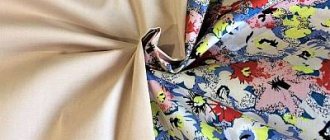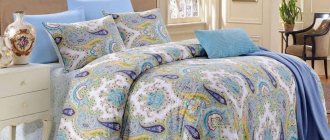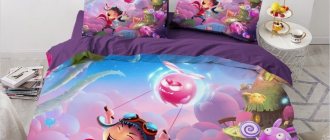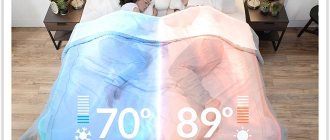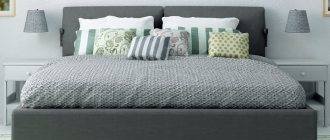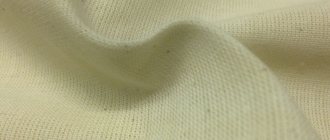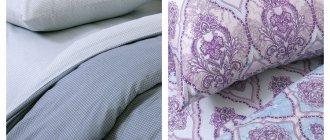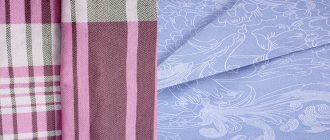Description and composition
Photo No. 3 Herbarium
Bed linen made of calico is the right choice.
- This is an environmentally friendly material with increased wear resistance.
- The printed pattern on the fabric is very durable and wash-resistant. Plainly dyed fabrics also do not fade or fade over time.
- A big plus of bedding made from calico is the inexpensive cost of everyday sets.
- Linen made from high-quality fabric will serve and delight its owners for many years.
- Gives slight shrinkage after washing.
Manufacturers
Photo No. 2
the Ivanovo and Shuya textile factories enjoys deserved popularity Their products are the most popular in Russia.
Despite the huge number of modifications of calico fabric, the quality remains unchanged - factories in Ivanovo produce exclusively natural fabrics.
Factory catalogs include casual linens and luxury gift bedding sets.
Foreign fabric manufacturers also deserve attention.
Ukraine, Belarus, Uzbekistan. Pakistan and India are proven and long-established countries in the production of cotton fabrics.
Their products are traditionally of good quality.
Chinese manufacturers often mix fibers by adding synthetics.
GOST will help
When choosing bedding sets made from calico, you should pay attention to the density of the fabric .
According to GOST, it is measured in grams per square meter. This indicator for calico is from 100 to 160. The lower the indicator, the thinner the fabric.
Fabric with index 145 is used for sewing linen in public bedrooms - barracks, hospitals, trains. For home use, fabric with a specific gravity of 125 .
Calico with a density of 100 will acquire sufficient density after the first wash, but will undergo shrinkage.
How to label laundry?
It all starts with the manufacturer. He orders codes in the Honest ZNAK system, observing the above rules. Both sets and individual types of products (for example, a duvet cover) can be marked.
When a manufacturer sells a batch of goods, he is obliged to generate a UTD (universal transfer document) and send it electronically (exclusively) to the buyer.
The buyer checks the product codes in the UPD with the codes on the product and signs the UPD in the electronic document management system.
If the buyer is a wholesaler and then sells the purchased goods in batches to retailers, then the process is repeated: he issues the UPD, the document is checked, signed, etc. This ensures control over goods throughout their movement to the final consumer.
On October 15, we held a webinar “Labelling 2020: clothing, textiles, photos, perfumes and tires.” In addition to experts from MoegoSklad, representatives of Chestny ZNAK and OFD.ru also spoke at the event.
Get the webinar recording
We have already mentioned that underwear can be sold both as individual products and as a set. If the kit was assembled by the manufacturer, then it has one marking code.
But if a store salesperson decides to put individual textile products into a set, for example, to run a “Three for the price of two” promotion, then each product in the set will have its own labeling code.
In this case, before the sale, the seller enters the following data into the labeling system:
- your TIN;
- dialing code;
- list of codes included in the set of goods.
What is marking?
It is important to properly store and use bed linen.
“Tagging” the product helps with this. But before you figure out how bed linen is labeled, you need to understand what the procedure itself is. Let's start with this! So, labeling is a kind of text that characterizes a product. These are signs, inscriptions and symbols that can be found both on the product itself and on its packaging. It's like a food composition.
Acquaintance with a product usually begins with studying such a label and checking whether what is written corresponds to the real one. If the labeling does not meet the requirements of the standard, then a fine will be charged from the enterprise that produced these products and made such labeling.
Mandatory labeling of bed linen from 2021
Mandatory labeling of bed linen, which refers to the supply of each unit of product with unique codes, will be introduced from December 1, 2021. Along with bed linen, the following products produced by light industry enterprises also fall under the system:
- clothing made of genuine or composite leather. This will also include work clothes;
- blouses, blouses;
- capes, coats, jackets, windbreakers;
- table linen, kitchen and toilet linen.
Who is involved in the labeling system?
The labeling procedure will involve all entities involved in the sale of goods from the moment they are released from production until they directly fall into the hands of the final consumer:
- manufacturer. He is obligated to apply a unique code to each unit of the product. From this moment it begins to be listed in the general system and is removed from the database only after it is sold to the end consumer. You will first need to register with the IP, purchase equipment that allows you to comply with all legal norms and requirements, and make sure that the installed software will allow you to carry out the necessary actions (or install new software). Unique codes must be ordered in advance, taking into account the expected production volumes. During the operation of the system at the pilot project stage, receiving them is completely free (until December 2021). In the future, the estimated price for one unit may be 50 kopecks;
- importer. Along with the manufacturer, a company engaged in importing must similarly ensure that only those goods that already contain a unique code are put on sale. It is worth considering that control over the presence of control and identification marks (CIS) will be carried out at the import stage. Thus, the coding procedure can be established during direct release into circulation or at the stage of formation of batches of products intended for sale in the Russian Federation;
- a company or organization engaged in the sale of goods. When purchasing bed linen, store management must ensure that it is registered. This happens automatically by scanning at the time of acceptance of batches of products shipped to a retail chain or store;
- final point of sale (checkout). Similarly, with the acceptance of products, information about the product is deleted at the time of scanning at the checkout and the release of goods. After the end consumer purchases bed linen, data about it is excluded from the general system. It is noteworthy that it is impossible to reuse codes that have already gone out of circulation, and especially counterfeit ones. When reading a non-existent code, the system automatically reports the detected violation. The data is transferred to regulatory organizations and the persons responsible for the release of such goods into sale are held accountable;
- consumer. First of all, if a product is found on sale that was not provided with unique codes, any buyer has the right to report the identified fact of violation to regulatory organizations. In addition, the functioning system assumes the ability to install a special “Honest Sign” application on the phone. By scanning the code, such an application makes it possible to obtain information about the product and determine whether the code applied to it is unique and valid.
The order of operation of the system may become somewhat more complicated when additional operations appear, in which it becomes necessary to remove the product from circulation:
- identification of defects or damage incompatible with the possibility of further sale;
- theft;
- return (when there is a need to re-register, but at the point of sale level);
- the need for write-off due to past expiration dates (this is more relevant for food products, which also fall under the system).
All emerging issues are necessarily described in the relevant regulations and methodological recommendations, formed based on the analysis of pilot projects.
What do textile labeling codes look like, what information does it include?
As with other labeled products, 2D DataMatrix barcodes must be used for linen. The code is applied to the label, packaging or tag.
What does the marking code contain:
- individual serial number of the product (13 characters);
- product code GTIN (14 digits);
- verification key (4 characters);
- verification code (44 characters).
To recognize the information encrypted in the code, a 2D scanner or data collection terminal (DCT) is used.
Marking of leftover bed linen is carried out in a simplified way. In the codes of such goods it is enough to indicate:
- country of origin;
- code and trademark;
- two nomenclature symbols;
- age category.
Simplified codes do not have any restrictions; their validity period is unlimited.
Similar rules apply for table linen But the entry in the classifier contains 15 clarifying codes. This means that knitted table linen created by machine or hand knitting, linen made from cotton yarn and chemical threads need to be specially marked.
In addition to such products as beach towels and bathing sheets, gloves also fell into the category of toilet linen
Detailed information on the rules for labeling all types of textiles and methodological recommendations are contained in Government Decree No. 1956.

